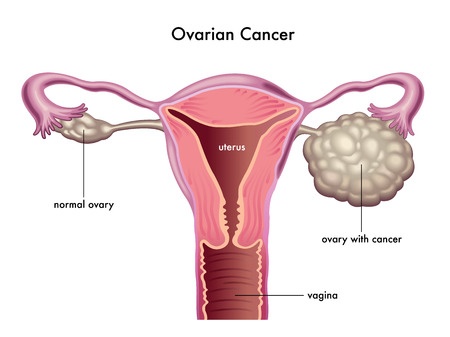 Ovarian cancer is cancer that starts in a woman’s ovaries. There are many different types of ovarian cancer, which are distinguished by the type of cell in which the cancer begins.
Ovarian cancer is cancer that starts in a woman’s ovaries. There are many different types of ovarian cancer, which are distinguished by the type of cell in which the cancer begins.Ovarian cancer is a very aggressive disease and frequently remains undetected until it reaches an advanced stage. Although the disease is associated with a high fatality rate, if diagnosed early, while it is still contained in the ovary, ovarian cancer has a 90 percent cure rate.
Ovarian Cancer Types
There are three main types of ovarian cancer. The vast majority are epithelial cell cancers. Epithelial cell cancer starts in the cells covering the surface of the ovary. Nearly 90 percent of ovarian cancers fall within this category.
Germ cell cancers begin in the reproductive cells of the ovary. This type of ovarian cancer is much less common and is most often seen in younger women.
Stromal ovarian cancer is a rare cancer that arises from the connective tissue of the ovary. Both germ cell and stromal ovarian cancers have high cure rates.
Epithelial Ovarian Cancer Risk Factors
- Over 55 years of age
- BRACA1 or BRACA2 genetic mutation
- Personal history of breast cancer
- Family history of certain types of cancer including breast, ovarian, colon or endometrial
- Nulliparity (never been pregnant)
- Infertility
- Endometriosis
Ovarian Cancer Symptoms
Ovarian cancer is sometimes called the silent killer because symptoms don’t typically appear until the disease reaches an advanced stage. Even then, symptoms may be vague and non-specific. They include:
- Abdominal bloating or increased abdominal size
- Fullness that occurs quickly when eating
- Weight loss
- Pelvic pain or discomfort
- Constipation
Ovarian Cancer Diagnosis
If the above symptoms are persistent, your OBGYN will likely perform a physical exam along with a pelvic examination. A transvaginal ultrasound may be done to visualize the ovaries.
Your gynecologist may also order a blood test to check for CA 125, a protein located on the surface of ovarian cancer cells.
To confirm a suspected diagnosis of ovarian cancer, a biopsy of the ovary may also be performed. Usually, this is a minimally invasive procedure.
Treatment of Ovarian Cancer
Treatment of ovarian cancer depends on the cancer’s stage. Epithelial ovarian cancer ranges from stage I – the least invasive stage – to stage IV, the most advanced.
Stage I – cancer is contain in one or both ovaries
Stage II – cancer has spread outside the ovaries to the pelvis
Stage III – cancer has spread to the abdomen
Stage IV – cancer has spread beyond the abdomen to other parts of the body
Stage I ovarian cancer may be treated by removal of the affected ovary and fallopian tube. More advanced disease usually involves the surgical removal of both ovaries, fallopian tubes and uterus. Adjacent lymph nodes and a section of fatty abdominal tissue may also be removed, since the cancer often spreads to these areas.
Chemotherapy typically follows surgery to target any remaining cancer cells. Colonoscopy, computed tomography (CT) scan, MRI, ultrasound, chest x-ray and other tests may be done to determine the extent of the cancer and whether or not it has spread.
Regular check-ups and close follow-up after treatment is vital.
